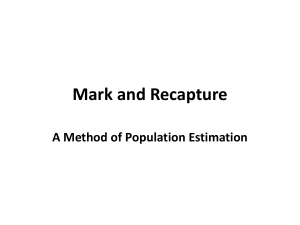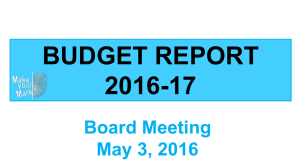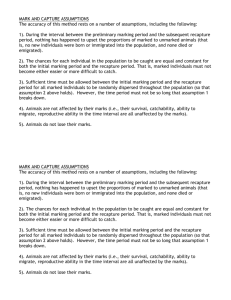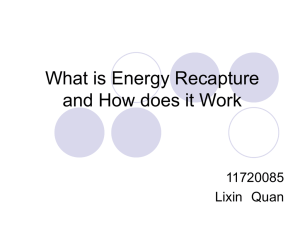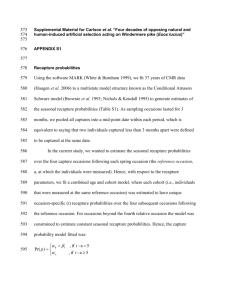U.S. TREAS Form treas-irs-8611-1999
advertisement
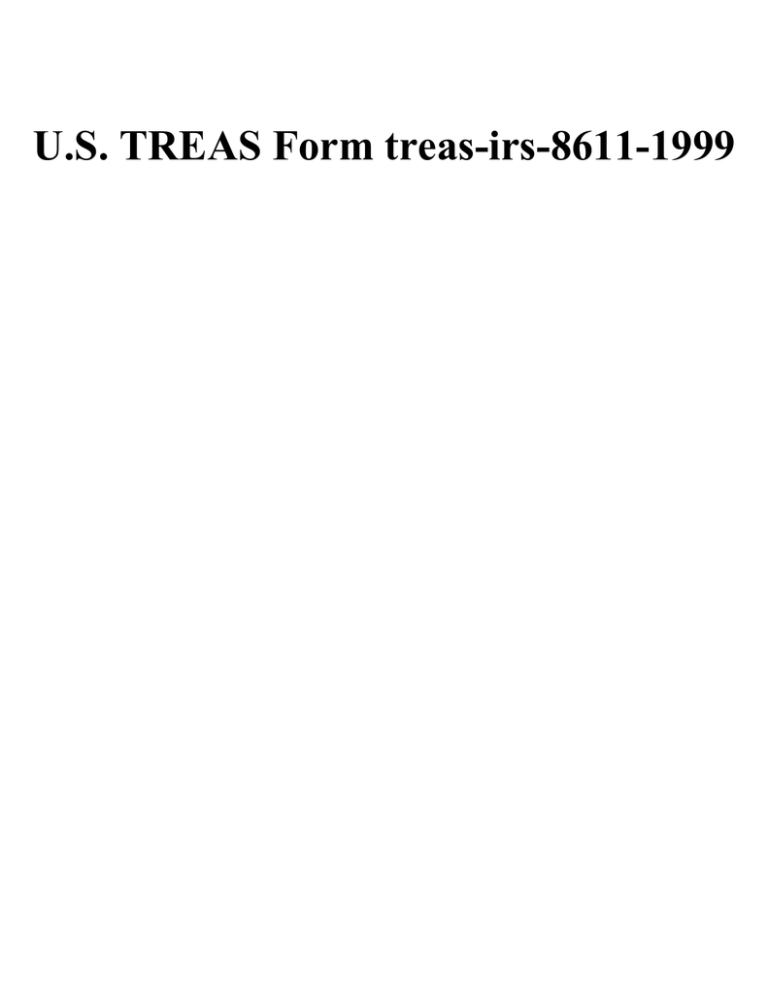
U.S. TREAS Form treas-irs-8611-1999 Form 8611 Recapture of Low-Income Housing Credit � (Rev. January 1999) Department of the Treasury Internal Revenue Service Note: Complete a separate Form 8611 for each building to which recapture applies. A Name(s) shown on return C Address of building (as shown on Form 8609) F OMB No. 1545-1035 Attach to your return. D Building identification number (BIN) Attachment Sequence No. 90 B Identifying number E Date placed in service (from Form 8609) If building is financed in whole or part with tax-exempt bonds, see instructions and furnish: (1) Issuer’s name (2) Date of issue (3) Name of issue (4) CUSIP number Note: If recapture is passed through from a flow-through entity (partnership, S corporation, estate, or trust), skip lines 1 – 7 and go to line 8. 1 2 3 4 5 Enter total credits reported on Form 8586 in prior years for this building Credits included on line 1 attributable to additions to qualified basis (see instructions) Credits subject to recapture. Subtract line 2 from line 1 Credit recapture percentage (see instructions) Accelerated portion of credit. Multiply line 3 by line 4 1 2 3 4 5 6 Percentage decrease in qualified basis. Express as a decimal amount carried out to at least 3 places (see instructions) 6 7 Amount of accelerated portion recaptured. Multiply line 5 by line 6. Section 42(j)(5) partnerships, go to line 13. All other flow-through entities (except electing large partnerships), enter the result here and enter each recipient’s share on the appropriate line of Schedule K-1. Generally, flow-through entities other than electing large partnerships will stop here. (Note: An estate or trust enters on line 8 only its share of recapture amount attributable to the credit amount reported on its Form 8586. ) Enter recapture amount from flow-through entity Enter accelerated portion of the unused credit attributable to this building (see instructions) Net recapture. Subtract line 9 from line 7 or line 8. If less than zero, enter -0Enter interest on the line 10 recapture amount (see instructions) Total recapture. Add lines 10 and 11. Enter here and on the appropriate line of your tax return. If more than one Form 8611 is filed, add the line 12 amounts from all forms and enter the total on the appropriate line of your return. Electing large partnerships, see instructions 8 9 10 11 12 . . 7 8 9 10 11 12 Only Section 42(j)(5) partnerships need to complete lines 13 and 14. 13 14 13 14 Enter interest on the line 7 recapture amount (see instructions) Total recapture. Add lines 7 and 13 (see instructions) General Instructions Section references are to the Internal Revenue Code. Purpose of Form Use this form if you must recapture part of the low-income housing credit you took in previous years because: ● The qualified basis of a building decreased from one year to the next, or ● You disposed of the building or an ownership interest in it, and you did not post a satisfactory bond or pledge eligible U.S. Treasury securities as collateral. For details on how to avoid recapture on a building disposition, see section 42(j)(6); Form 8693, Low-Income Housing Credit Disposition Bond; and Rev. Proc. 99-11, 1999-2 I.R.B. 14. Note: If the decrease in qualified basis is because of a change in the amount for which you are financially at risk on the building, then you must first recalculate the amount of credit taken in prior years under section 42(k) before you calculate the recapture amount on this form. To complete this form you will need copies of the following forms that you have filed: Form 8586, Low-Income Housing Credit (and Form 3800, General Business Credit, if applicable); Form 8609, Low-Income Housing Credit Allocation Certification; Schedule A (Form 8609), Annual Statement; and Form 8611. Note: Flow-through entities must give partners, shareholders, and beneficiaries the information that is reported in items C, D, E, and F of Form 8611. Generally, recapture applies if: ● You dispose of a building or an ownership interest in it; ● There is a decrease in the qualified basis of the building from one year to the next; or ● The building no longer meets the minimum set-aside requirements of section 42(g)(1), the gross rent requirement of section 42(g)(2), or the other requirements for the units which are set aside. However, recapture does not apply if: ● You disposed of the building or an ownership interest in it and you posted a satisfactory bond or pledged eligible U.S. For Paperwork Reduction Act Notice, see page 2. Cat. No. 63983Q Treasury securities as collateral (for details, see section 42(j)(6); Form 8693; and Rev. Proc. 99-11); ● You disposed of an ownership interest in a building that you held through an electing large partnership; ● The decrease in qualified basis does not exceed the additions to qualified basis for which credits were allowable in years after the year the building was placed in service; ● You correct a noncompliance event within a reasonable period after it is discovered or should have been discovered; ● The credit did not reduce your tax liability (but you must adjust the allowable general business credit carryback and carryforward); or ● The qualified basis is reduced because of a casualty loss, provided the property is restored or replaced within a reasonable period. Recordkeeping Requirements To verify changes in qualified basis from year to year, you must keep, for 3 years after the 15-year compliance period ends, a copy of all Forms 8586, 8609, Schedule A (Form 8609), 8611, and 8693. Form 8611 (Rev. 1-99) Form 8611 (Rev. 1-99) Page Specific Instructions Note: If recapture is passed through from a flow-through entity (partnership, S corporation, estate or trust), skip lines 1–7 and go to line 8. Item F. If the building is financed with tax-exempt bonds, furnish the following information: (1) name of the entity that issued the bond (not the name of the entity receiving the benefit of the financing); (2) date of issue, generally the first date there is a physical exchange of the bonds for the purchase price; (3) name of the issue, or if not named, other identification of the issue; and (4) CUSIP number of the bond with the latest maturity date. If the issue does not have a CUSIP number, enter “None.” Line 1. Enter the total credits claimed on the building for all prior years from Part I, Form 8586 (before reduction due to the tax liability limit). No credit may be claimed in the year of recapture. See Part I of Form(s) 8586 you have filed. Do not include credits taken by a previous owner. Line 2. Determine the amount to enter on this line by completing a separate Line 2 Worksheet (below) for each prior year for which line 7 of Schedule A (Form 8609) was completed. Line 4. Enter the credit recapture percentage, expressed as a decimal carried to at least 3 places, from the table below: IF the recapture event occurs in . . . THEN enter on line 4 . . . Years 2 through 11 .333 Year 12 .267 Year 13 .200 Year 14 .133 Year 15 .067 Line 6. Enter the percentage decrease in qualified basis from the close of the previous year to the close of the current year. For this purpose, figure qualified basis without regard to any additions to qualified basis after the first year of the credit period. Compare any decrease in qualified basis first to additions to qualified basis. Recapture applies only if the decrease in qualified basis exceeds additions to qualified basis after the first year of the credit period. If you disposed of the building or an ownership interest in it and did not post a bond, you must recapture all of the accelerated portion shown on line 5. Enter 1.000 on line 6. Note: If the decrease causes the qualified basis to fall below the minimum set-aside requirements of section 42(g)(1) (the 20-50 test or the 40-60 test), then 100% of the amount shown on line 5 must be recaptured. Enter 1.000 on line 6. If you elected the 40-60 test for this building and the decrease causes you to fall below 40%, you cannot switch to the 20-50 test to meet the set-aside requirements. You must recapture the entire amount shown on line 5. Line 9. Multiply the unused credits attributable to this building by the decimal amount on line 4 and enter the result on line 9. Reduce the amount of any unused credit by the amount of recapture before claiming any carryforward of the low-income housing credit on Form 3800. See the separate Instructions for Form 3800 for details on the carryforward of unused credits. Special rule for electing large partnerships. Enter zero on line 9. An electing large partnership is treated as having fully used all prior year credits. Line 11. Compute the interest separately for each prior tax year for which a credit is being recaptured. Interest must be computed at the overpayment rate determined under section 6621(a)(1) and compounded on a daily basis from the due date (not including extensions) of the return for the prior year until the earlier of (a) the due date (not including extensions) of the return for the recapture year, or (b) the date the return for the recapture year is filed and any income tax due for that year has been fully paid. Tables of interest factors to compute daily compound interest were published in Rev. Proc. 95-17, 1995-1 C.B. 556. The annual interest rate in effect and the corresponding page number in 1995-1 C.B. for periods through March 31, 1999, are shown in Rev. Rul. 98–61, 1998–51 I.R.B. 8. For periods after March 31, 1999, use the overpayment rate under section 6621(a)(1) in the revenue rulings published quarterly in the Internal Revenue Bulletin. Line 2 Worksheet Enter the amount from line 10, Schedule A (Form 8609) a b Multiply a by 2 b c Enter the amount from line 11, Schedule A (Form 8609) c d Subtract c from b d e Enter decimal amount figured in step 1 of the instructions for line 14, Schedule A (Form 8609). If line 14 does not apply to you, enter -0­ e a f Multiply d by e g Subtract f from d f g h Divide line 16, Schedule A (Form 8609) by line 15, Schedule A (Form 8609). Enter the result here h Multiply g by h. Enter this amount on line 2. (If more than one worksheet is completed, add the amounts on i from all worksheets and enter the total on line 2.) i i 2 Note: If the line 8 recapture amount is from a section 42(j)(5) partnership, the partnership will figure the interest and include it in the recapture amount reported to you. Enter “-0-” on line 11 and write “Section 42(j)(5)” to the left of the entry space for line 11. Line 12. Special rule for electing large partnerships. Subtract the current year credit, if any, shown on Form 8586, line 7, from the total of the line 12 amounts from all Forms 8611. Enter the result (but not less than zero) on Form 1065-B, Part I, line 26. Note: You must also reduce the current year low-income housing credit, before entering it on Schedules K and K-1, by the amount of the reduction to the total of the recapture amounts. Lines 13 and 14. Only section 42(j)(5) partnerships complete these lines. This is a partnership (other than an electing large partnership) that has at least 35 partners, unless the partnership elects (or has previously elected) not to be treated as a section 42(j)(5) partnership. For purposes of this definition, a husband and wife are treated as one partner. For purposes of determining the credit recapture amount, a section 42(j)(5) partnership is treated as the taxpayer to which the low-income housing credit was allowed and as if the amount of credit allowed was the entire amount allowable under section 42(a). See the instructions for line 11 to figure the interest on line 13. The partnership must attach Form 8611 to its Form 1065 and allocate this amount to each partner on Schedule K-1 (Form 1065) in the same manner as the partnership’s taxable income is allocated to each partner. Paperwork Reduction Act Notice. We ask for the information on this form to carry out the Internal Revenue laws of the United States. You are required to give us the information. We need it to ensure that you are complying with these laws and to allow us to figure and collect the right amount of tax. You are not required to provide the information requested on a form that is subject to the Paperwork Reduction Act unless the form displays a valid OMB control number. Books or records relating to a form or its instructions must be retained as long as their contents may become material in the administration of any Internal Revenue law. Generally, tax returns and return information are confidential, as required by section 6103. The time needed to complete and file this form will vary depending on individual circumstances. The estimated average time is: 6 hr., 56 min. Recordkeeping Learning about the law or the form 1 hr., 5 min. Preparing and sending the form to the IRS 1 hr., 16 min. If you have comments concerning the accuracy of these time estimates or suggestions for making this form simpler, we would be happy to hear from you. You can write to the IRS at the address listed in the instructions for the tax return with which this form is filed.
